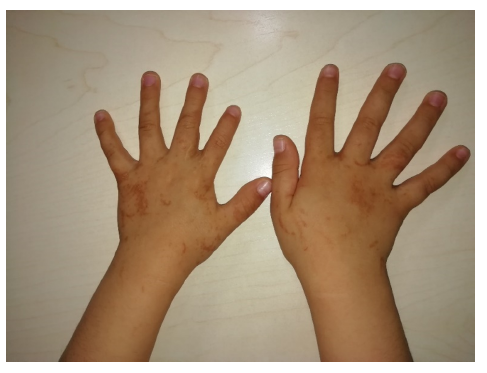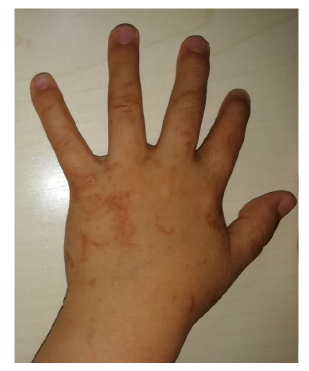A four-year-old boy presented to the Dermatology consultation due to asymptomatic rash on the back of both hands with one week of evolution (Figure 1). Numerous erythematous macules and papules were evident, many with linear arciform configuration (Figure 2). The boy had been playing with plants the day before.
What is your diagnosis?
Diagnosis
The diagnosis of phytophotodermatitis was straightforward in the present case. Retrospectively, when shown a photography, the boy’s mother recognized the plants as being common rues (Ruta graveolens), one of the most acknowledged photodermatitis-inducing plant. The mother was reassured of the auto-limited nature of the condition, and no treatment was prescribed. Spontaneous recovery was observed after several weeks.
Discussion
Phototoxic reactions are non-immunologic sunburn-like reactions caused by photosensitizers that reach the skin topically or systemically.1 Phytophotodermatitis is a contact plant-induced photosensitivity and the commonest phototoxic reaction in children. Most of these reactions result from furocoumarin compounds (psoralens) found, for instance, in limes, lemons, parsley, figs, and common rue. After contact with these photosensitizers, UVA light exposure results in inflammation and subsequent hyperpigmentation.2
Phytophotodermatitis ranges from mild erythema to severe blistering, depending on the intensity of sun exposure, type of plant, and extent of contact.1,2 It usually appears within one day after exposure. Bizarre linear streaking or arciform lesions or marks from the leaves and stalks are typically seen on skin-exposed areas.1,3 The intensity of the inflammatory reaction correlates to the residual brownish or purple hyperpigmentation.1
The diagnosis is clinical, elicited by the presence of bizarre linear lesions on areas exposed to both sun and plant.4 In bullous phytophotodermatitis, burns, infections, and autoimmune dermatosis are usually excluded by clinical criteria.5,6 The streaking pattern and residual hyperpigmentation should not be mistaken for child abuse.1,2
No treatment is usually required in non-bullous phytophotodermatitis, as in the present case. Hyperpigmentation fades away spontaneously within weeks.2 In cases with pruritic inflammation, topical corticosteroids are indicated.1,2 Prevention is possible by washing the areas that contacted potential phototoxic plants and applying a photoprotector.1,2,7
Take-home messages
In children presenting with erythematous or brownish macules and papules on sun-exposed areas, particularly if showing a bizarre pattern, phytophotodermatitis should be considered in the differential diagnosis.
Skin washing immediately after contact with potential psoralen-containing plants and avoiding sunlight in contact areas prevent these reactions.
Complete and spontaneous resolution is the most common outcome, but residual hyperpigmentation may take several weeks to months to resolve.

















